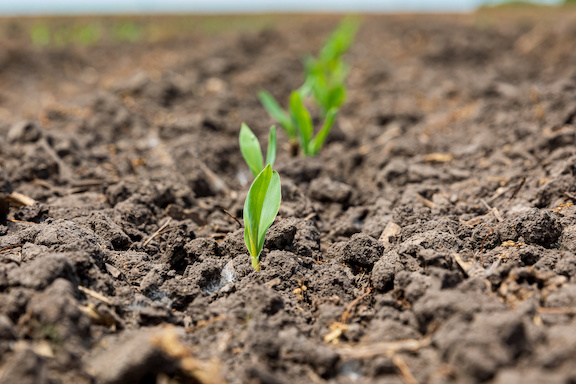Once Corn’s Planted, Check Emergence
May 10, 2023

The rush is on to get seed in the ground. Once you’ve checked (and re-checked) the planter it’s time to watch for those seeds to emerge – and then do some more checking!
“The staple of corn emergence is to have a ‘picket fence,’” said Craig Loen, agronomy sales rep at the Osceola location. Look for “uniform emergence, plants at the same stage, no ‘runts’ or doubles,” he said.
“Take a look across the field … see if you see any troubled areas, big spaces between plants, double plants in close proximity, uneven plant sizes,” he said. For future reference (with regard to your planter), “dig up the seeds to see if they are planted too shallow; you need that uniform, consistent planting depth.”
Scout early, when corn is at V1 or V2. “Count collars, not leaves, to stage corn,” Loen said. To scout corn for emergence and determine plant population, grab a few tools:
The goal is “consistent, uniform corn plants,” said Loen.
Look at the soil. Is there any side wall smearing, compaction, crusting, residue, tillage? Are any plants mudded in?
Remember: Corn plants that emerge two or more days after initial emergence tend to become “weeds” to the corn plants that emerge ahead of it. Even plant emergence helps ensure even crop development.
The planter can be responsible for many issues early on, so keep an eye on what’s going into the ground now – and then check the field early on to see how things are emerging.
Ask your local Federated Agronomist to stop by and look at your emerging crops, too! “You only get one chance a year to plant,” said Loen. “Make sure you do it right.”
“The staple of corn emergence is to have a ‘picket fence,’” said Craig Loen, agronomy sales rep at the Osceola location. Look for “uniform emergence, plants at the same stage, no ‘runts’ or doubles,” he said.
“Take a look across the field … see if you see any troubled areas, big spaces between plants, double plants in close proximity, uneven plant sizes,” he said. For future reference (with regard to your planter), “dig up the seeds to see if they are planted too shallow; you need that uniform, consistent planting depth.”
Scout early, when corn is at V1 or V2. “Count collars, not leaves, to stage corn,” Loen said. To scout corn for emergence and determine plant population, grab a few tools:
- a shovel,
- a piece of rope, 17 ft., 5 in. long,
- a tape measure,
- a seed depth tool,
- a couple of wooden or metal stakes,
- and a soil thermometer.
- Count the plants in one row and multiply by 1000 to determine plants per acre. (If you know the planting rate, you can determine the expected germination rate.)
- Take this same count in several areas of the field.
- There should be two plants per one foot of corn row. “Corn needs space to maximize growth,” said Loen.
The goal is “consistent, uniform corn plants,” said Loen.
Look at the soil. Is there any side wall smearing, compaction, crusting, residue, tillage? Are any plants mudded in?
Remember: Corn plants that emerge two or more days after initial emergence tend to become “weeds” to the corn plants that emerge ahead of it. Even plant emergence helps ensure even crop development.
The planter can be responsible for many issues early on, so keep an eye on what’s going into the ground now – and then check the field early on to see how things are emerging.
Ask your local Federated Agronomist to stop by and look at your emerging crops, too! “You only get one chance a year to plant,” said Loen. “Make sure you do it right.”